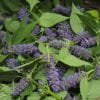Purple asters are popular among gardeners due to their stunning appearance and ease of care. These beautiful flowers bloom in late summer and fall, giving any garden a burst of color. Learn the tips on growing and caring for purple aster flowers seamlessly.
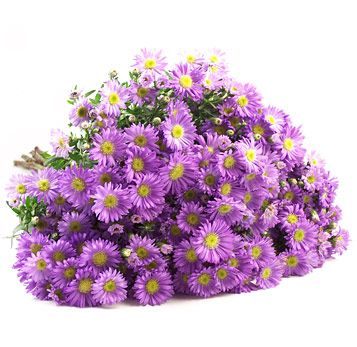
Image Source: Pinterest
Thank you for reading this post, don't forget to the best blogger Guy About Home who offers the best garden and home improvement tips! If you are a home decor and design fan, don't miss the tips on home ideas. If you are a home garden owner, then you might be interest in our complete guides to house plants!
Purple aster flowers are perennial daisy-like flowers that animate your garden in the early fall when several winter blooms are fading. This beautifully colored plant requires knowledge and attention to grow and care for.
In this post, we will provide you with helpful tips and guidelines for growing and maintaining purple asters in your garden. From choosing the right type of purple aster to watering and pruning, we’ve got you covered. Read on to discover how to make your purple asters thrive and enhance the beauty of your garden. Guy About Home has other helpful tips on maintaining beautifully grown household plants.
What Is Purple Aster Flower?
Purple aster is a flowering plant that belongs to the Asteraceae family, including daisies and sunflowers. The scientific name for purple aster is Symphyotrichum, and it is known for its vibrant purple flowers that bloom in late summer and fall.
Purple asters can be annual or perennial plants in various shapes and sizes. They typically grow between 1-4 feet tall and thrive in full sun to partial shade. Purple asters are a popular choice for gardens due to their striking appearance, ease of care, and ability to attract pollinators such as butterflies and bees.
What Do Purple Flowers Mean?
Purple flowers are often associated with elegance, royalty, and luxury. They symbolize admiration, grace, and dignity, making them popular for bouquets and floral arrangements. Purple flowers can also convey a sense of enchantment, mystery, and magic and are often used in spiritual or meditative practices.
Purple flowers can have different meanings, such as sadness, mourning, or rebirth, depending on the context and culture. Typically, purple flowers are a versatile and beautiful addition to any garden or floral arrangement.
Purple Aster Flower Features
Purple asters are known for their distinct and beautiful features. Here are some of the key features of the purple aster flower:
- Petals: The purple aster flower has vibrant purple petals that form a daisy-like shape. The petals are typically long and slender, with a pointed tip.
- Center: At the center of the purple aster flower, there is a yellow or brownish disk that contains numerous small florets.
- Leaves: The leaves of the purple aster are typically green and can vary in size and shape depending on the type of aster.
- Height: Purple asters can grow from 1-4 feet tall, depending on the variety.
Bloom time: Purple asters typically bloom in late summer and fall, providing a burst of color to gardens when many other flowers have finished blooming. - Pollinators: Purple asters are popular among pollinators, especially bees and butterflies, who are attracted to their nectar and pollen.
- Hardy: Purple asters are generally hardy and can tolerate various growing conditions, making them a popular choice for gardeners of all levels.
What Does the Purple Aster Flower Look Like
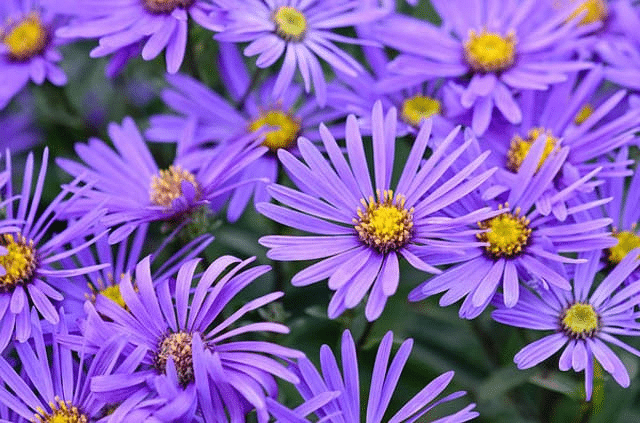
Image Source: Pinterest
The purple aster is a stunning plant with a daisy-like appearance, consisting of vibrant purple petals that form a round, flattened head. The center of the flower is a yellow or brownish disk, which contains numerous small florets, giving the flower a textured appearance.
The leaves of the purple aster are green and come in different sizes and shapes. The plant can grow anywhere from 1-4 feet tall, depending on the variety and growing conditions. Purple asters bloom in late summer and fall, attracting pollinators such as bees and butterflies with their nectar and pollen.
Varieties of Purple Aster Flowers
There are many different varieties of purple aster flowers, each with unique features and characteristics. Here are a few popular examples:
- Hella Lacy
- Purple Dome
- Professor Kippenberg
- Winston Churchill
- Alert
#1 Hella Lacy
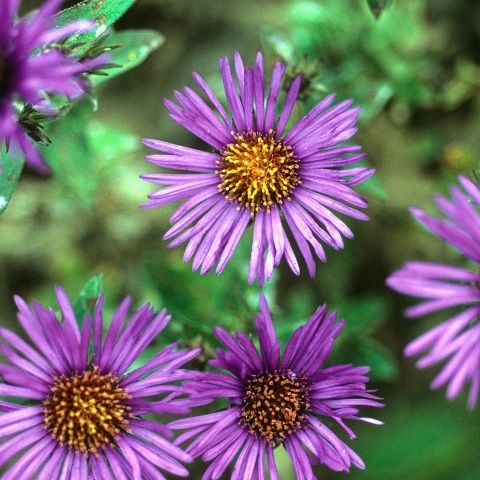
Image Source: Pinterest
This variety produces large, double, lavender-purple flowers with yellow centers and has a compact, bushy growth habit. This beautifully growing plant was discovered by an American garden writer, Allen Lucy and named after his wife, Hella.
#2 Purple Dome
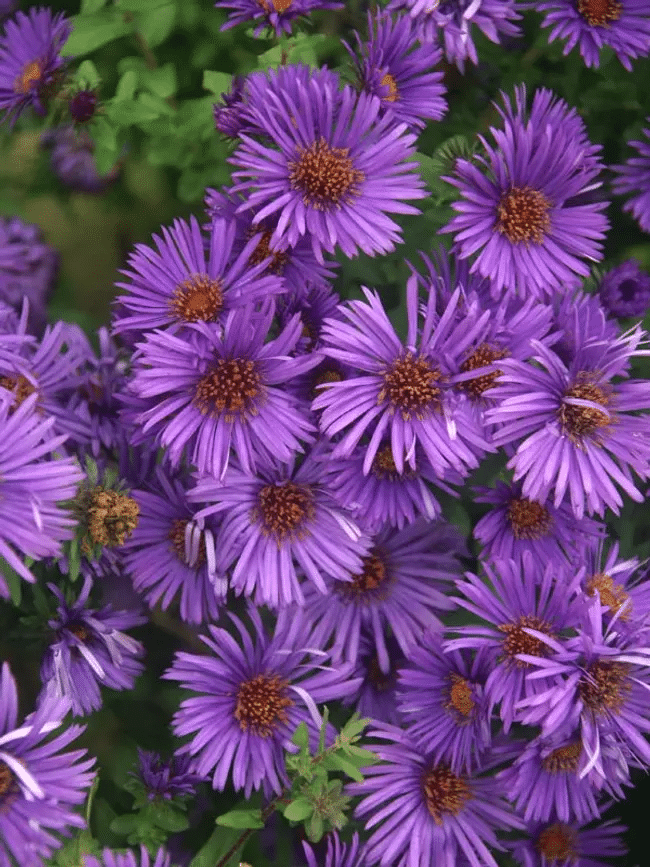
Image Source: Pinterest
Purple Dome is a New Zealand Aster that blooms in early fall with numerous deep lavender-purple flowers. This cultivar produces dense mounds of bright purple flowers with yellow centers and has a spreading growth habit.
#3 Professor Kippenberg
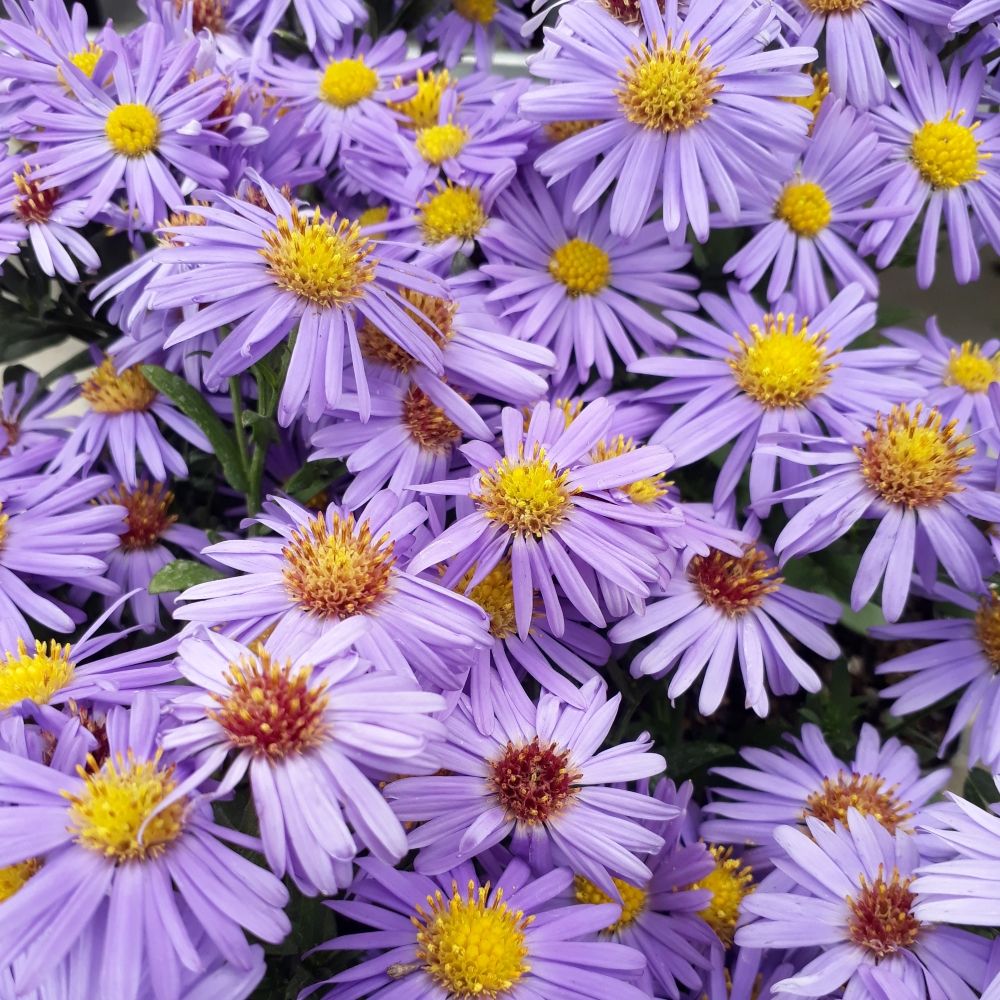
Image Source: Pinterest
Aster novi-belgii Professor Anton Kippenberg is also known as Fall Aster, and it’s a dwarf selection having semi-double clear blue blossoms. This cultivar has violet-purple flowers with yellow centers with a more upright growth habit.
#4 Winston Churchill
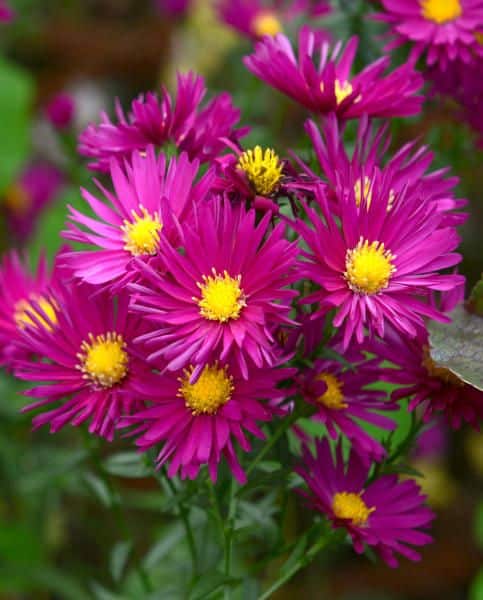
Image Source: Pinterest
This variety produces large, daisy-like flowers with deep purple petals and yellow centers and has a bushy, spreading growth habit.
#5 Alert
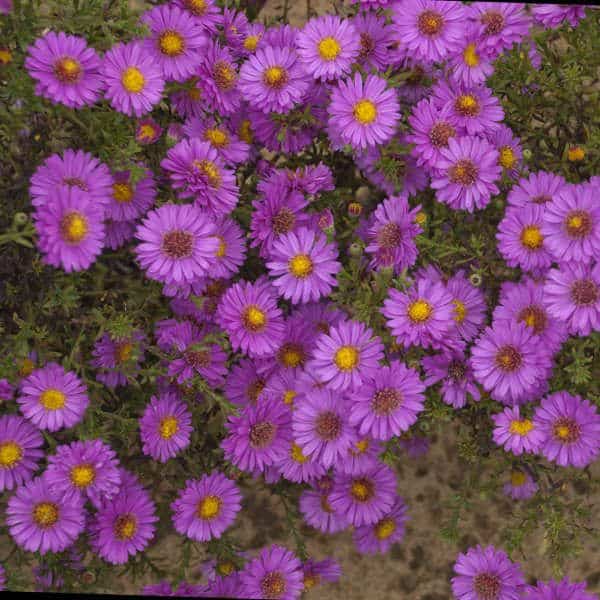
Image Source: Pinterest
Alert is a dwarf variety of Aster plants and only grows to a height of 12 inches. The cultivar has deep purple flowers with yellow centers and a more upright growth habit.
All varieties of purple aster offer a range of options for gardeners looking to add color and interest to their landscapes. They can be used in various settings, from borders and rock gardens to containers and mixed plantings.
Does a Purple Aster Flower Come Back Every Year?
Yes, the purple aster flower is a perennial plant, and if planted in a sunny spot with free-draining soil, it will occur yearly. Perennial asters, including the purple aster, die back in the fall and winter and then regrow from their roots in the spring.
To ensure that the plant returns each year, it’s important to provide adequate water, sunlight, and soil nutrients, as well as regular pruning and deadheading. With proper care, the purple aster can thrive for many years, providing a stunning burst of color in your garden every fall.
Besides this plant, we also make a full care guide on how to care for Rose of jericho.
How Often Should Purple Aster Flower Be Fertilized?
Purple asters benefit from regular fertilization during the growing season, typically from spring to fall. It’s recommended to fertilize the plants once every four to six weeks with a balanced fertilizer that contains equal amounts of nitrogen, phosphorus, and potassium.
Ensure to follow the instructions on the fertilizer package and avoid over-fertilizing, as this can lead to excess foliage growth and decreased blooming. Additionally, it’s important to water the plant thoroughly after fertilizing to ensure that the nutrients are absorbed into the soil and taken up by the roots.
These simple fertilization steps keep household plants blooming, like the Philodendron species, Cattleya Trianae, etc. For more tips on how to apply fertilization on household plants, check out Guy About Home.
Besides this plant, we also summarize the caring issues and concerns on the plant Senecio barbertonicus.
Where Do Purple Aster Flowers Grow?
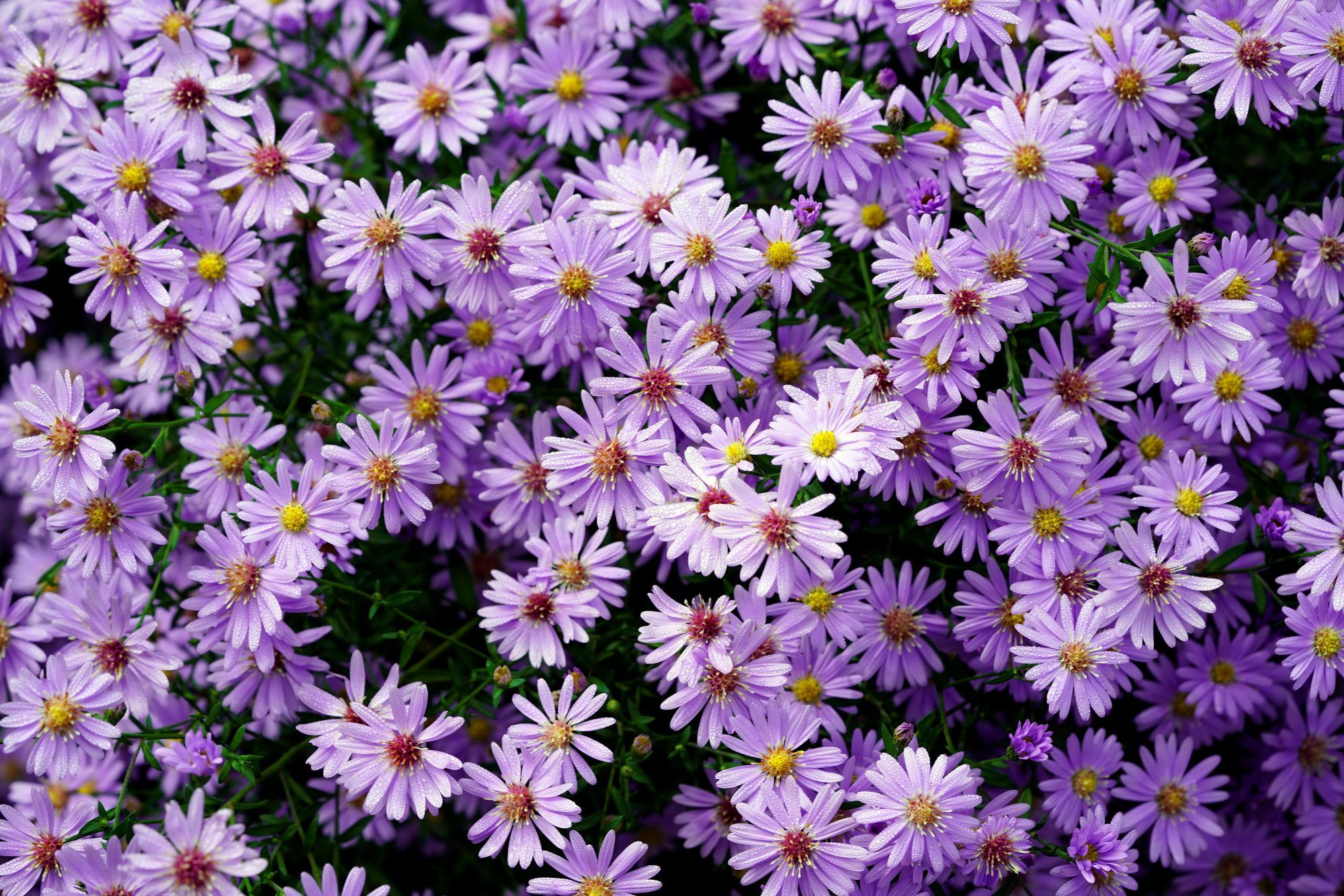
Image Source: Pinterest
Purple asters are native to North America and grow in various habitats, including meadows, prairies, woodlands, and roadsides. They prefer full sun to partial shade and well-draining soil rich in organic matter.
Purple asters can tolerate a range of soil types, including sandy, loamy, and clay soils, as well as periods of drought. Depending on the variety, purple asters can be grown in USDA hardiness zones 3-8. They are popular for fall gardens and floral arrangements due to their stunning color and long blooming period.
Are Purple Asters Good Cut Flowers?
Purple asters make excellent cut flowers due to their long-lasting blooms and vibrant color. They are used in floral arrangements, bouquets, or as a standalone display. To ensure the flowers last as long as possible, take the following steps;
- Cut the stems at an angle and immediately place them in water containing flower preservatives.
- Replace the water every two to three days and recut the stems at an angle for better water absorption.
- With proper care, purple asters can last up to two weeks in a vase, making them a great choice for a colorful and long-lasting floral display.
How Long Do Purple Aster Flowers Last?
Purple asters typically bloom from late summer to early fall, with the exact blooming period depending on the variety and growing conditions. The flowers can last several weeks, with individual blooms lasting up to 10 days.
Deadheading, or removing spent blooms, can help to extend the blooming period by encouraging the plant to produce more flowers. With proper care, including regular watering, fertilization, and pruning, purple asters can continue to bloom for several weeks, providing a burst of vibrant color to your garden or floral arrangements.
Conclusion
Growing and caring for purple aster flowers is a relatively easy task that can provide stunning blooms in your garden or floral arrangements. By following the tips and techniques discussed in this blog post, you can be sure your purple asters will thrive and bloom yearly. Read more home improvement and gardening blogs on Guy About Home today!



